Business Strategy Report: Analyzing L'Oreal's Strategic Position
VerifiedAdded on 2020/10/05
|16
|4532
|162
Report
AI Summary
This report provides a comprehensive analysis of L'Oreal's business strategy, exploring its macro and internal environments. It begins with an introduction to business strategy and its importance, followed by a detailed PESTLE analysis of L'Oreal, examining political, economic, social, technological, legal, and environmental factors influencing the company. The report then delves into the internal environment, utilizing SWOT analysis to assess L'Oreal's strengths, weaknesses, opportunities, and threats. Furthermore, the VRIO model is applied to evaluate the company's resources and capabilities. The report also includes an analysis using Porter's Five Forces to assess the competitive landscape, including the threat of new entrants, substitute products, and the bargaining power of suppliers and consumers. The report concludes with a discussion on strategic management decisions, objectives, and tactical priorities based on the preceding analyses. The report aims to provide insights into L'Oreal's strategic position and competitive advantages within the cosmetics industry.
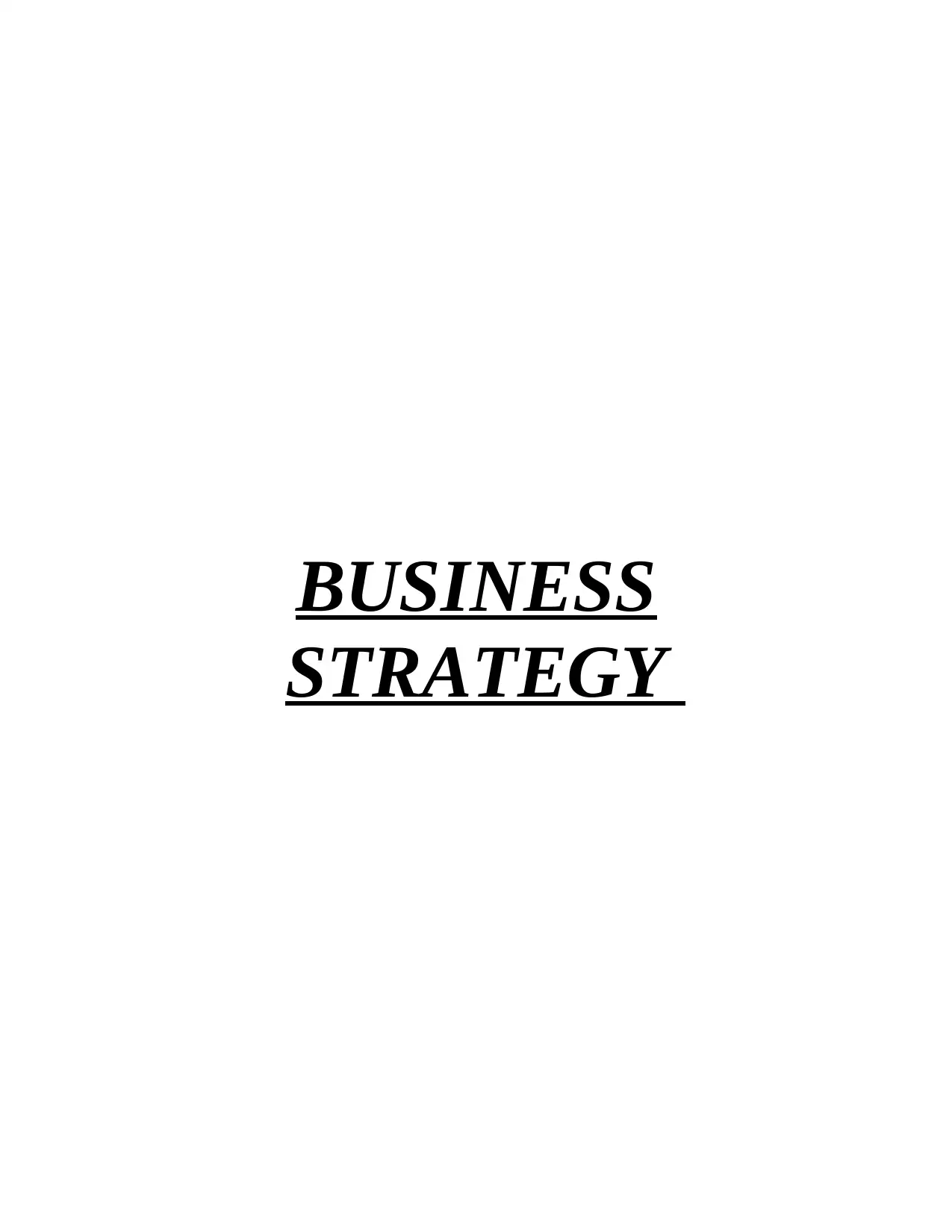
BUSINESS
STRATEGY
STRATEGY
Paraphrase This Document
Need a fresh take? Get an instant paraphrase of this document with our AI Paraphraser
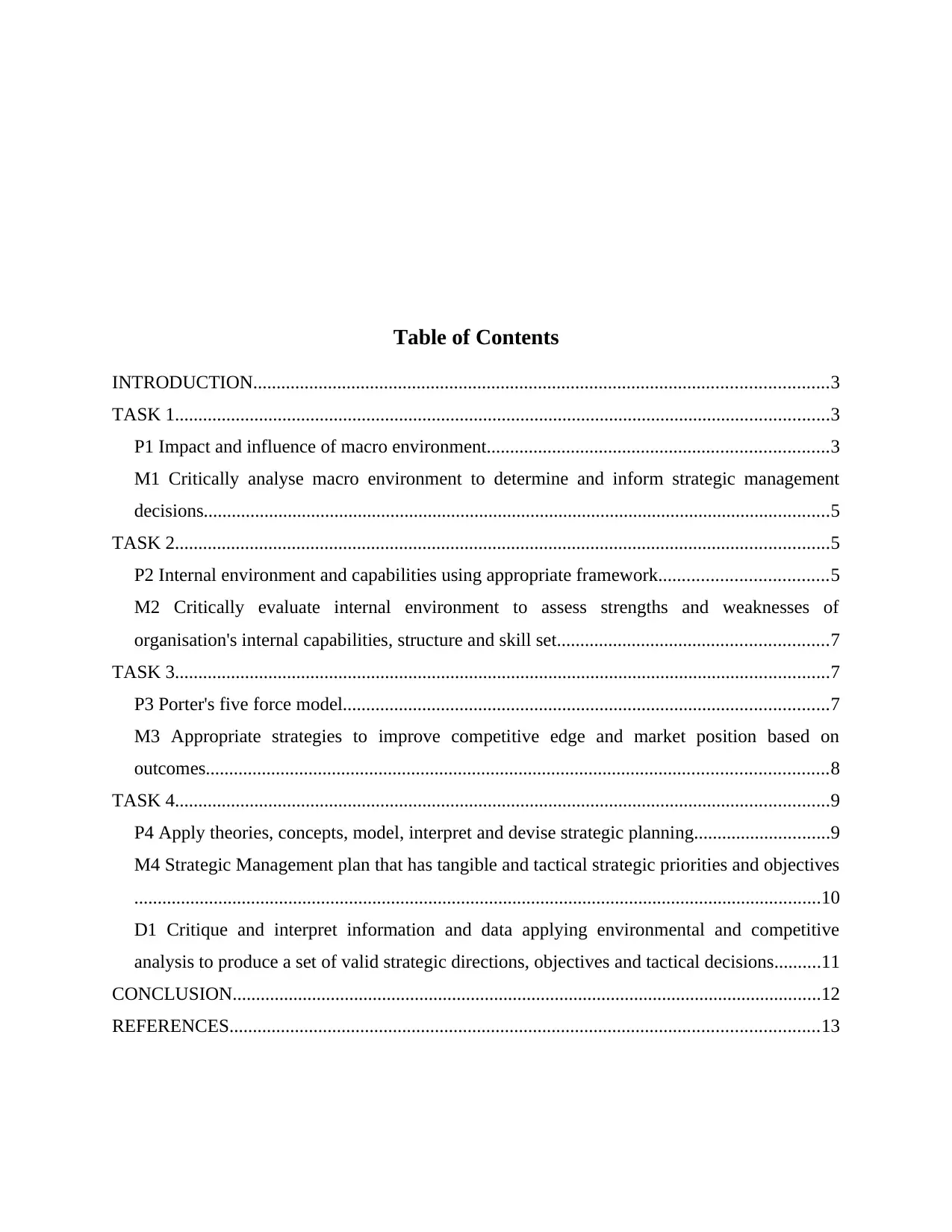
Table of Contents
INTRODUCTION...........................................................................................................................3
TASK 1............................................................................................................................................3
P1 Impact and influence of macro environment.........................................................................3
M1 Critically analyse macro environment to determine and inform strategic management
decisions......................................................................................................................................5
TASK 2............................................................................................................................................5
P2 Internal environment and capabilities using appropriate framework....................................5
M2 Critically evaluate internal environment to assess strengths and weaknesses of
organisation's internal capabilities, structure and skill set..........................................................7
TASK 3............................................................................................................................................7
P3 Porter's five force model........................................................................................................7
M3 Appropriate strategies to improve competitive edge and market position based on
outcomes.....................................................................................................................................8
TASK 4............................................................................................................................................9
P4 Apply theories, concepts, model, interpret and devise strategic planning.............................9
M4 Strategic Management plan that has tangible and tactical strategic priorities and objectives
...................................................................................................................................................10
D1 Critique and interpret information and data applying environmental and competitive
analysis to produce a set of valid strategic directions, objectives and tactical decisions..........11
CONCLUSION..............................................................................................................................12
REFERENCES..............................................................................................................................13
INTRODUCTION...........................................................................................................................3
TASK 1............................................................................................................................................3
P1 Impact and influence of macro environment.........................................................................3
M1 Critically analyse macro environment to determine and inform strategic management
decisions......................................................................................................................................5
TASK 2............................................................................................................................................5
P2 Internal environment and capabilities using appropriate framework....................................5
M2 Critically evaluate internal environment to assess strengths and weaknesses of
organisation's internal capabilities, structure and skill set..........................................................7
TASK 3............................................................................................................................................7
P3 Porter's five force model........................................................................................................7
M3 Appropriate strategies to improve competitive edge and market position based on
outcomes.....................................................................................................................................8
TASK 4............................................................................................................................................9
P4 Apply theories, concepts, model, interpret and devise strategic planning.............................9
M4 Strategic Management plan that has tangible and tactical strategic priorities and objectives
...................................................................................................................................................10
D1 Critique and interpret information and data applying environmental and competitive
analysis to produce a set of valid strategic directions, objectives and tactical decisions..........11
CONCLUSION..............................................................................................................................12
REFERENCES..............................................................................................................................13
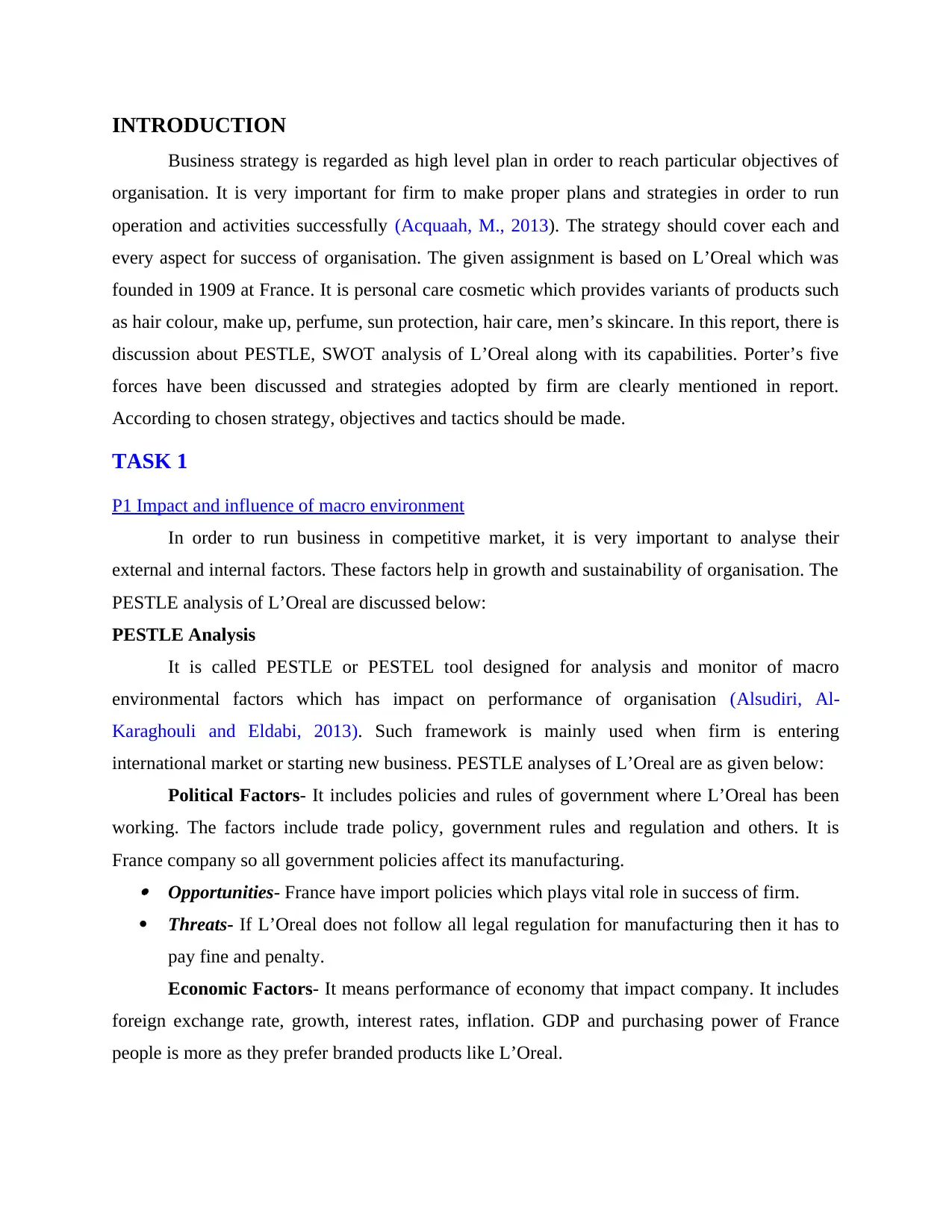
INTRODUCTION
Business strategy is regarded as high level plan in order to reach particular objectives of
organisation. It is very important for firm to make proper plans and strategies in order to run
operation and activities successfully (Acquaah, M., 2013). The strategy should cover each and
every aspect for success of organisation. The given assignment is based on L’Oreal which was
founded in 1909 at France. It is personal care cosmetic which provides variants of products such
as hair colour, make up, perfume, sun protection, hair care, men’s skincare. In this report, there is
discussion about PESTLE, SWOT analysis of L’Oreal along with its capabilities. Porter’s five
forces have been discussed and strategies adopted by firm are clearly mentioned in report.
According to chosen strategy, objectives and tactics should be made.
TASK 1
P1 Impact and influence of macro environment
In order to run business in competitive market, it is very important to analyse their
external and internal factors. These factors help in growth and sustainability of organisation. The
PESTLE analysis of L’Oreal are discussed below:
PESTLE Analysis
It is called PESTLE or PESTEL tool designed for analysis and monitor of macro
environmental factors which has impact on performance of organisation (Alsudiri, Al-
Karaghouli and Eldabi, 2013). Such framework is mainly used when firm is entering
international market or starting new business. PESTLE analyses of L’Oreal are as given below:
Political Factors- It includes policies and rules of government where L’Oreal has been
working. The factors include trade policy, government rules and regulation and others. It is
France company so all government policies affect its manufacturing. Opportunities- France have import policies which plays vital role in success of firm.
Threats- If L’Oreal does not follow all legal regulation for manufacturing then it has to
pay fine and penalty.
Economic Factors- It means performance of economy that impact company. It includes
foreign exchange rate, growth, interest rates, inflation. GDP and purchasing power of France
people is more as they prefer branded products like L’Oreal.
Business strategy is regarded as high level plan in order to reach particular objectives of
organisation. It is very important for firm to make proper plans and strategies in order to run
operation and activities successfully (Acquaah, M., 2013). The strategy should cover each and
every aspect for success of organisation. The given assignment is based on L’Oreal which was
founded in 1909 at France. It is personal care cosmetic which provides variants of products such
as hair colour, make up, perfume, sun protection, hair care, men’s skincare. In this report, there is
discussion about PESTLE, SWOT analysis of L’Oreal along with its capabilities. Porter’s five
forces have been discussed and strategies adopted by firm are clearly mentioned in report.
According to chosen strategy, objectives and tactics should be made.
TASK 1
P1 Impact and influence of macro environment
In order to run business in competitive market, it is very important to analyse their
external and internal factors. These factors help in growth and sustainability of organisation. The
PESTLE analysis of L’Oreal are discussed below:
PESTLE Analysis
It is called PESTLE or PESTEL tool designed for analysis and monitor of macro
environmental factors which has impact on performance of organisation (Alsudiri, Al-
Karaghouli and Eldabi, 2013). Such framework is mainly used when firm is entering
international market or starting new business. PESTLE analyses of L’Oreal are as given below:
Political Factors- It includes policies and rules of government where L’Oreal has been
working. The factors include trade policy, government rules and regulation and others. It is
France company so all government policies affect its manufacturing. Opportunities- France have import policies which plays vital role in success of firm.
Threats- If L’Oreal does not follow all legal regulation for manufacturing then it has to
pay fine and penalty.
Economic Factors- It means performance of economy that impact company. It includes
foreign exchange rate, growth, interest rates, inflation. GDP and purchasing power of France
people is more as they prefer branded products like L’Oreal.
⊘ This is a preview!⊘
Do you want full access?
Subscribe today to unlock all pages.

Trusted by 1+ million students worldwide
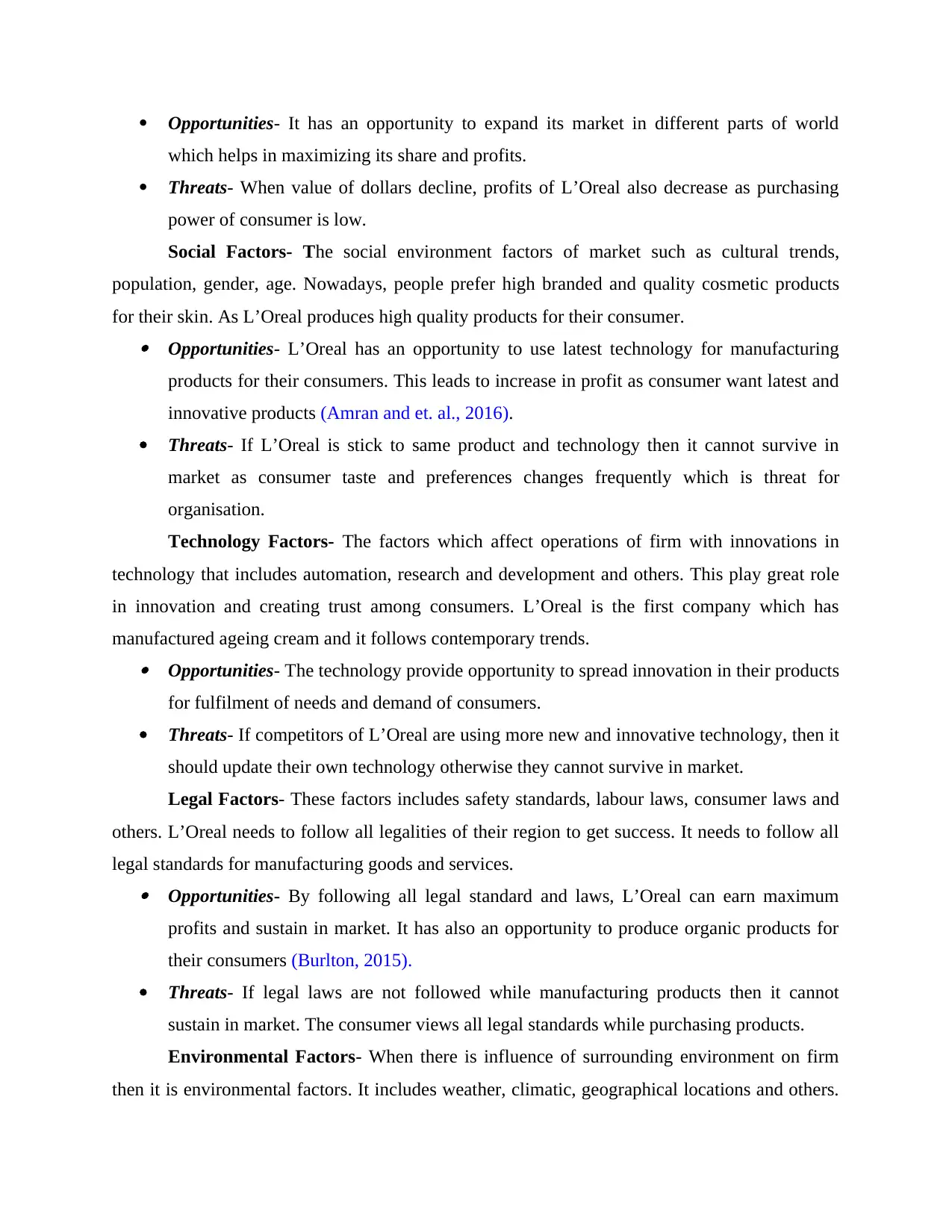
Opportunities- It has an opportunity to expand its market in different parts of world
which helps in maximizing its share and profits.
Threats- When value of dollars decline, profits of L’Oreal also decrease as purchasing
power of consumer is low.
Social Factors- The social environment factors of market such as cultural trends,
population, gender, age. Nowadays, people prefer high branded and quality cosmetic products
for their skin. As L’Oreal produces high quality products for their consumer. Opportunities- L’Oreal has an opportunity to use latest technology for manufacturing
products for their consumers. This leads to increase in profit as consumer want latest and
innovative products (Amran and et. al., 2016).
Threats- If L’Oreal is stick to same product and technology then it cannot survive in
market as consumer taste and preferences changes frequently which is threat for
organisation.
Technology Factors- The factors which affect operations of firm with innovations in
technology that includes automation, research and development and others. This play great role
in innovation and creating trust among consumers. L’Oreal is the first company which has
manufactured ageing cream and it follows contemporary trends. Opportunities- The technology provide opportunity to spread innovation in their products
for fulfilment of needs and demand of consumers.
Threats- If competitors of L’Oreal are using more new and innovative technology, then it
should update their own technology otherwise they cannot survive in market.
Legal Factors- These factors includes safety standards, labour laws, consumer laws and
others. L’Oreal needs to follow all legalities of their region to get success. It needs to follow all
legal standards for manufacturing goods and services. Opportunities- By following all legal standard and laws, L’Oreal can earn maximum
profits and sustain in market. It has also an opportunity to produce organic products for
their consumers (Burlton, 2015).
Threats- If legal laws are not followed while manufacturing products then it cannot
sustain in market. The consumer views all legal standards while purchasing products.
Environmental Factors- When there is influence of surrounding environment on firm
then it is environmental factors. It includes weather, climatic, geographical locations and others.
which helps in maximizing its share and profits.
Threats- When value of dollars decline, profits of L’Oreal also decrease as purchasing
power of consumer is low.
Social Factors- The social environment factors of market such as cultural trends,
population, gender, age. Nowadays, people prefer high branded and quality cosmetic products
for their skin. As L’Oreal produces high quality products for their consumer. Opportunities- L’Oreal has an opportunity to use latest technology for manufacturing
products for their consumers. This leads to increase in profit as consumer want latest and
innovative products (Amran and et. al., 2016).
Threats- If L’Oreal is stick to same product and technology then it cannot survive in
market as consumer taste and preferences changes frequently which is threat for
organisation.
Technology Factors- The factors which affect operations of firm with innovations in
technology that includes automation, research and development and others. This play great role
in innovation and creating trust among consumers. L’Oreal is the first company which has
manufactured ageing cream and it follows contemporary trends. Opportunities- The technology provide opportunity to spread innovation in their products
for fulfilment of needs and demand of consumers.
Threats- If competitors of L’Oreal are using more new and innovative technology, then it
should update their own technology otherwise they cannot survive in market.
Legal Factors- These factors includes safety standards, labour laws, consumer laws and
others. L’Oreal needs to follow all legalities of their region to get success. It needs to follow all
legal standards for manufacturing goods and services. Opportunities- By following all legal standard and laws, L’Oreal can earn maximum
profits and sustain in market. It has also an opportunity to produce organic products for
their consumers (Burlton, 2015).
Threats- If legal laws are not followed while manufacturing products then it cannot
sustain in market. The consumer views all legal standards while purchasing products.
Environmental Factors- When there is influence of surrounding environment on firm
then it is environmental factors. It includes weather, climatic, geographical locations and others.
Paraphrase This Document
Need a fresh take? Get an instant paraphrase of this document with our AI Paraphraser
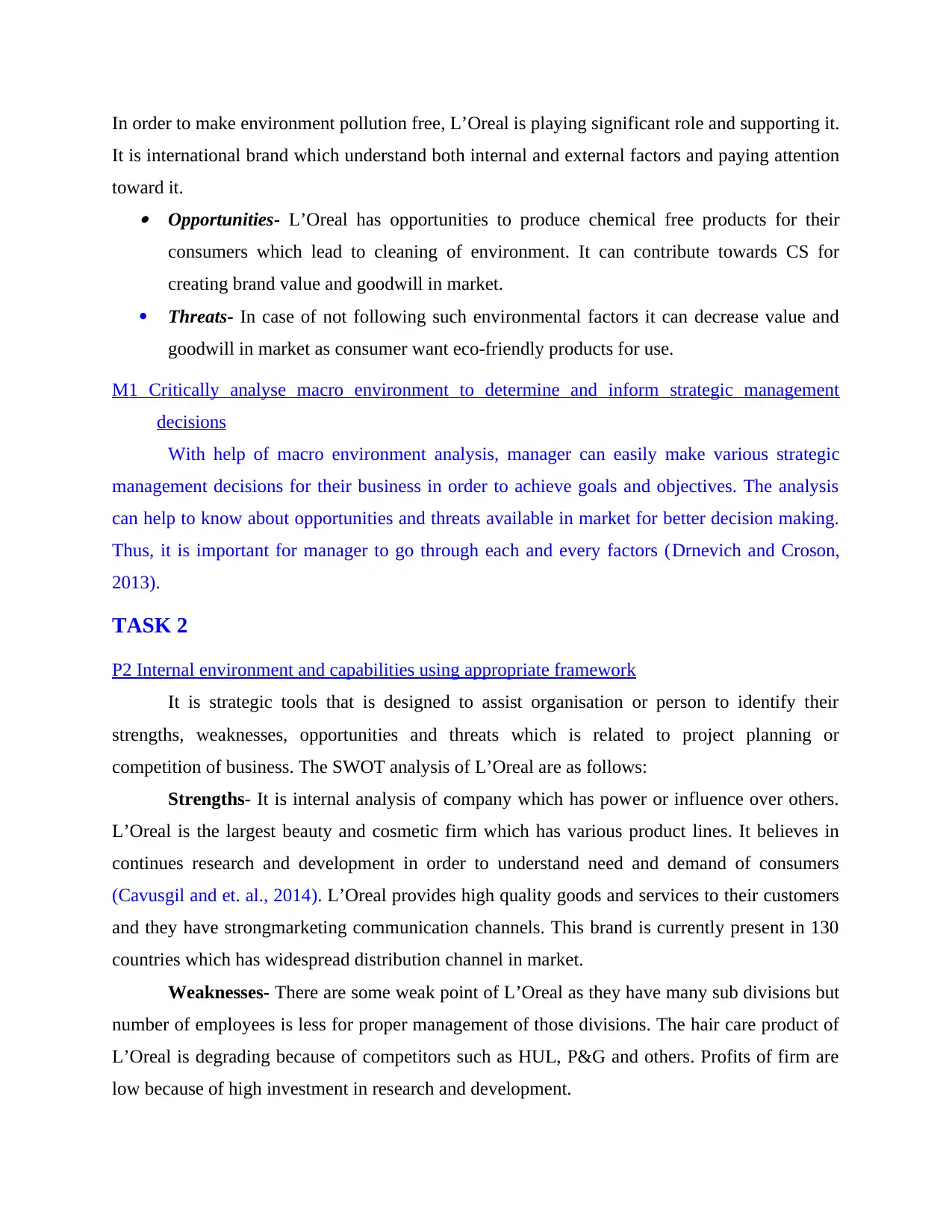
In order to make environment pollution free, L’Oreal is playing significant role and supporting it.
It is international brand which understand both internal and external factors and paying attention
toward it. Opportunities- L’Oreal has opportunities to produce chemical free products for their
consumers which lead to cleaning of environment. It can contribute towards CS for
creating brand value and goodwill in market.
Threats- In case of not following such environmental factors it can decrease value and
goodwill in market as consumer want eco-friendly products for use.
M1 Critically analyse macro environment to determine and inform strategic management
decisions
With help of macro environment analysis, manager can easily make various strategic
management decisions for their business in order to achieve goals and objectives. The analysis
can help to know about opportunities and threats available in market for better decision making.
Thus, it is important for manager to go through each and every factors (Drnevich and Croson,
2013).
TASK 2
P2 Internal environment and capabilities using appropriate framework
It is strategic tools that is designed to assist organisation or person to identify their
strengths, weaknesses, opportunities and threats which is related to project planning or
competition of business. The SWOT analysis of L’Oreal are as follows:
Strengths- It is internal analysis of company which has power or influence over others.
L’Oreal is the largest beauty and cosmetic firm which has various product lines. It believes in
continues research and development in order to understand need and demand of consumers
(Cavusgil and et. al., 2014). L’Oreal provides high quality goods and services to their customers
and they have strongmarketing communication channels. This brand is currently present in 130
countries which has widespread distribution channel in market.
Weaknesses- There are some weak point of L’Oreal as they have many sub divisions but
number of employees is less for proper management of those divisions. The hair care product of
L’Oreal is degrading because of competitors such as HUL, P&G and others. Profits of firm are
low because of high investment in research and development.
It is international brand which understand both internal and external factors and paying attention
toward it. Opportunities- L’Oreal has opportunities to produce chemical free products for their
consumers which lead to cleaning of environment. It can contribute towards CS for
creating brand value and goodwill in market.
Threats- In case of not following such environmental factors it can decrease value and
goodwill in market as consumer want eco-friendly products for use.
M1 Critically analyse macro environment to determine and inform strategic management
decisions
With help of macro environment analysis, manager can easily make various strategic
management decisions for their business in order to achieve goals and objectives. The analysis
can help to know about opportunities and threats available in market for better decision making.
Thus, it is important for manager to go through each and every factors (Drnevich and Croson,
2013).
TASK 2
P2 Internal environment and capabilities using appropriate framework
It is strategic tools that is designed to assist organisation or person to identify their
strengths, weaknesses, opportunities and threats which is related to project planning or
competition of business. The SWOT analysis of L’Oreal are as follows:
Strengths- It is internal analysis of company which has power or influence over others.
L’Oreal is the largest beauty and cosmetic firm which has various product lines. It believes in
continues research and development in order to understand need and demand of consumers
(Cavusgil and et. al., 2014). L’Oreal provides high quality goods and services to their customers
and they have strongmarketing communication channels. This brand is currently present in 130
countries which has widespread distribution channel in market.
Weaknesses- There are some weak point of L’Oreal as they have many sub divisions but
number of employees is less for proper management of those divisions. The hair care product of
L’Oreal is degrading because of competitors such as HUL, P&G and others. Profits of firm are
low because of high investment in research and development.
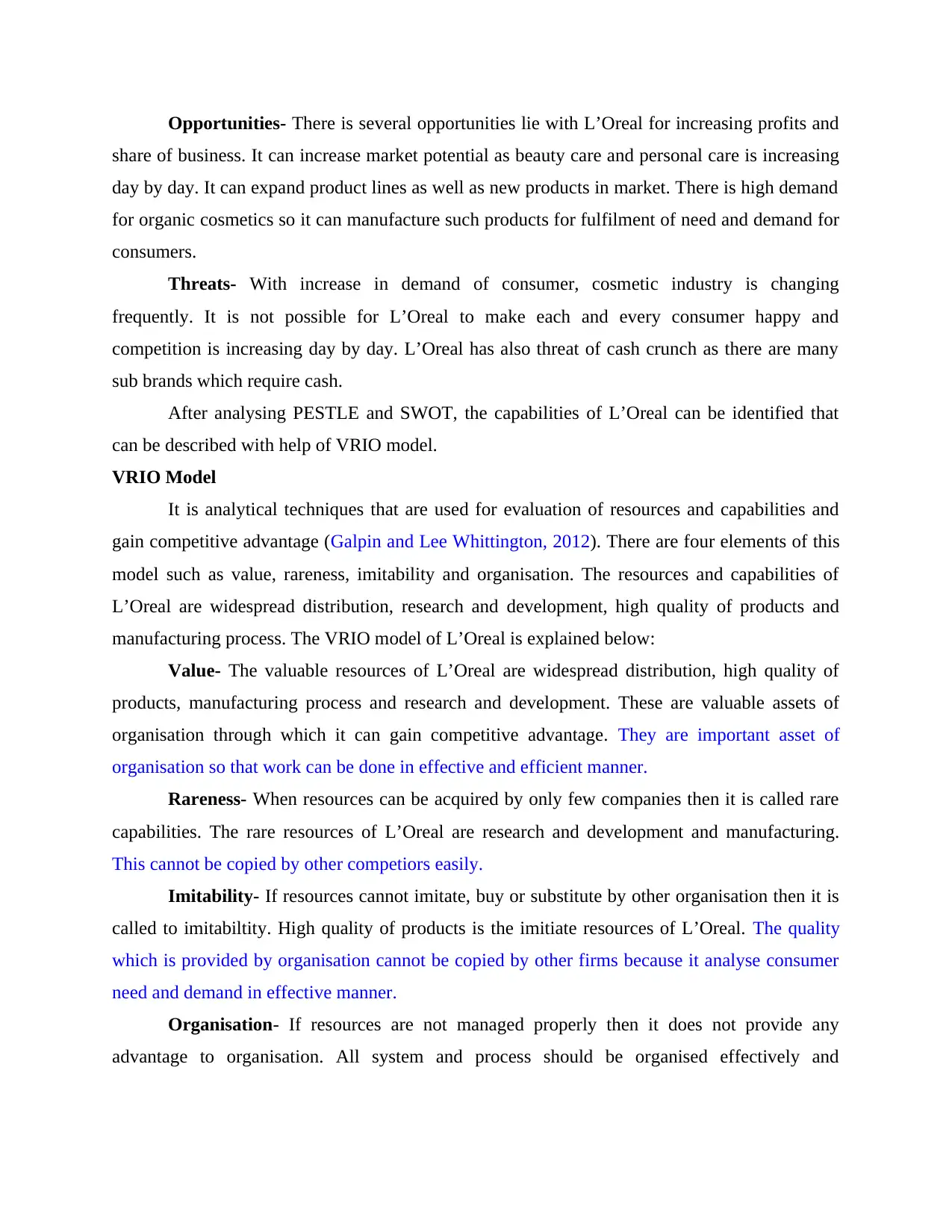
Opportunities- There is several opportunities lie with L’Oreal for increasing profits and
share of business. It can increase market potential as beauty care and personal care is increasing
day by day. It can expand product lines as well as new products in market. There is high demand
for organic cosmetics so it can manufacture such products for fulfilment of need and demand for
consumers.
Threats- With increase in demand of consumer, cosmetic industry is changing
frequently. It is not possible for L’Oreal to make each and every consumer happy and
competition is increasing day by day. L’Oreal has also threat of cash crunch as there are many
sub brands which require cash.
After analysing PESTLE and SWOT, the capabilities of L’Oreal can be identified that
can be described with help of VRIO model.
VRIO Model
It is analytical techniques that are used for evaluation of resources and capabilities and
gain competitive advantage (Galpin and Lee Whittington, 2012). There are four elements of this
model such as value, rareness, imitability and organisation. The resources and capabilities of
L’Oreal are widespread distribution, research and development, high quality of products and
manufacturing process. The VRIO model of L’Oreal is explained below:
Value- The valuable resources of L’Oreal are widespread distribution, high quality of
products, manufacturing process and research and development. These are valuable assets of
organisation through which it can gain competitive advantage. They are important asset of
organisation so that work can be done in effective and efficient manner.
Rareness- When resources can be acquired by only few companies then it is called rare
capabilities. The rare resources of L’Oreal are research and development and manufacturing.
This cannot be copied by other competiors easily.
Imitability- If resources cannot imitate, buy or substitute by other organisation then it is
called to imitabiltity. High quality of products is the imitiate resources of L’Oreal. The quality
which is provided by organisation cannot be copied by other firms because it analyse consumer
need and demand in effective manner.
Organisation- If resources are not managed properly then it does not provide any
advantage to organisation. All system and process should be organised effectively and
share of business. It can increase market potential as beauty care and personal care is increasing
day by day. It can expand product lines as well as new products in market. There is high demand
for organic cosmetics so it can manufacture such products for fulfilment of need and demand for
consumers.
Threats- With increase in demand of consumer, cosmetic industry is changing
frequently. It is not possible for L’Oreal to make each and every consumer happy and
competition is increasing day by day. L’Oreal has also threat of cash crunch as there are many
sub brands which require cash.
After analysing PESTLE and SWOT, the capabilities of L’Oreal can be identified that
can be described with help of VRIO model.
VRIO Model
It is analytical techniques that are used for evaluation of resources and capabilities and
gain competitive advantage (Galpin and Lee Whittington, 2012). There are four elements of this
model such as value, rareness, imitability and organisation. The resources and capabilities of
L’Oreal are widespread distribution, research and development, high quality of products and
manufacturing process. The VRIO model of L’Oreal is explained below:
Value- The valuable resources of L’Oreal are widespread distribution, high quality of
products, manufacturing process and research and development. These are valuable assets of
organisation through which it can gain competitive advantage. They are important asset of
organisation so that work can be done in effective and efficient manner.
Rareness- When resources can be acquired by only few companies then it is called rare
capabilities. The rare resources of L’Oreal are research and development and manufacturing.
This cannot be copied by other competiors easily.
Imitability- If resources cannot imitate, buy or substitute by other organisation then it is
called to imitabiltity. High quality of products is the imitiate resources of L’Oreal. The quality
which is provided by organisation cannot be copied by other firms because it analyse consumer
need and demand in effective manner.
Organisation- If resources are not managed properly then it does not provide any
advantage to organisation. All system and process should be organised effectively and
⊘ This is a preview!⊘
Do you want full access?
Subscribe today to unlock all pages.

Trusted by 1+ million students worldwide
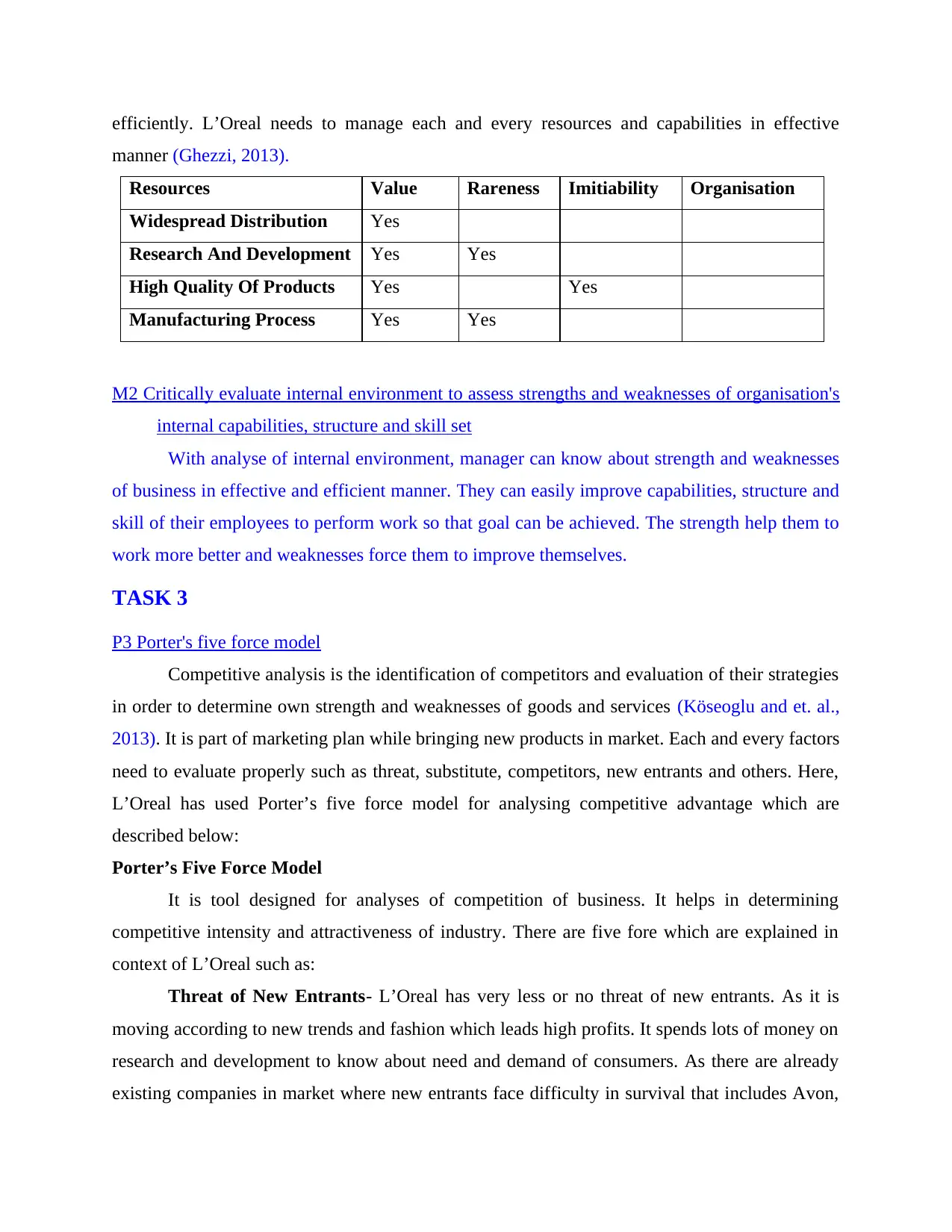
efficiently. L’Oreal needs to manage each and every resources and capabilities in effective
manner (Ghezzi, 2013).
Resources Value Rareness Imitiability Organisation
Widespread Distribution Yes
Research And Development Yes Yes
High Quality Of Products Yes Yes
Manufacturing Process Yes Yes
M2 Critically evaluate internal environment to assess strengths and weaknesses of organisation's
internal capabilities, structure and skill set
With analyse of internal environment, manager can know about strength and weaknesses
of business in effective and efficient manner. They can easily improve capabilities, structure and
skill of their employees to perform work so that goal can be achieved. The strength help them to
work more better and weaknesses force them to improve themselves.
TASK 3
P3 Porter's five force model
Competitive analysis is the identification of competitors and evaluation of their strategies
in order to determine own strength and weaknesses of goods and services (Köseoglu and et. al.,
2013). It is part of marketing plan while bringing new products in market. Each and every factors
need to evaluate properly such as threat, substitute, competitors, new entrants and others. Here,
L’Oreal has used Porter’s five force model for analysing competitive advantage which are
described below:
Porter’s Five Force Model
It is tool designed for analyses of competition of business. It helps in determining
competitive intensity and attractiveness of industry. There are five fore which are explained in
context of L’Oreal such as:
Threat of New Entrants- L’Oreal has very less or no threat of new entrants. As it is
moving according to new trends and fashion which leads high profits. It spends lots of money on
research and development to know about need and demand of consumers. As there are already
existing companies in market where new entrants face difficulty in survival that includes Avon,
manner (Ghezzi, 2013).
Resources Value Rareness Imitiability Organisation
Widespread Distribution Yes
Research And Development Yes Yes
High Quality Of Products Yes Yes
Manufacturing Process Yes Yes
M2 Critically evaluate internal environment to assess strengths and weaknesses of organisation's
internal capabilities, structure and skill set
With analyse of internal environment, manager can know about strength and weaknesses
of business in effective and efficient manner. They can easily improve capabilities, structure and
skill of their employees to perform work so that goal can be achieved. The strength help them to
work more better and weaknesses force them to improve themselves.
TASK 3
P3 Porter's five force model
Competitive analysis is the identification of competitors and evaluation of their strategies
in order to determine own strength and weaknesses of goods and services (Köseoglu and et. al.,
2013). It is part of marketing plan while bringing new products in market. Each and every factors
need to evaluate properly such as threat, substitute, competitors, new entrants and others. Here,
L’Oreal has used Porter’s five force model for analysing competitive advantage which are
described below:
Porter’s Five Force Model
It is tool designed for analyses of competition of business. It helps in determining
competitive intensity and attractiveness of industry. There are five fore which are explained in
context of L’Oreal such as:
Threat of New Entrants- L’Oreal has very less or no threat of new entrants. As it is
moving according to new trends and fashion which leads high profits. It spends lots of money on
research and development to know about need and demand of consumers. As there are already
existing companies in market where new entrants face difficulty in survival that includes Avon,
Paraphrase This Document
Need a fresh take? Get an instant paraphrase of this document with our AI Paraphraser
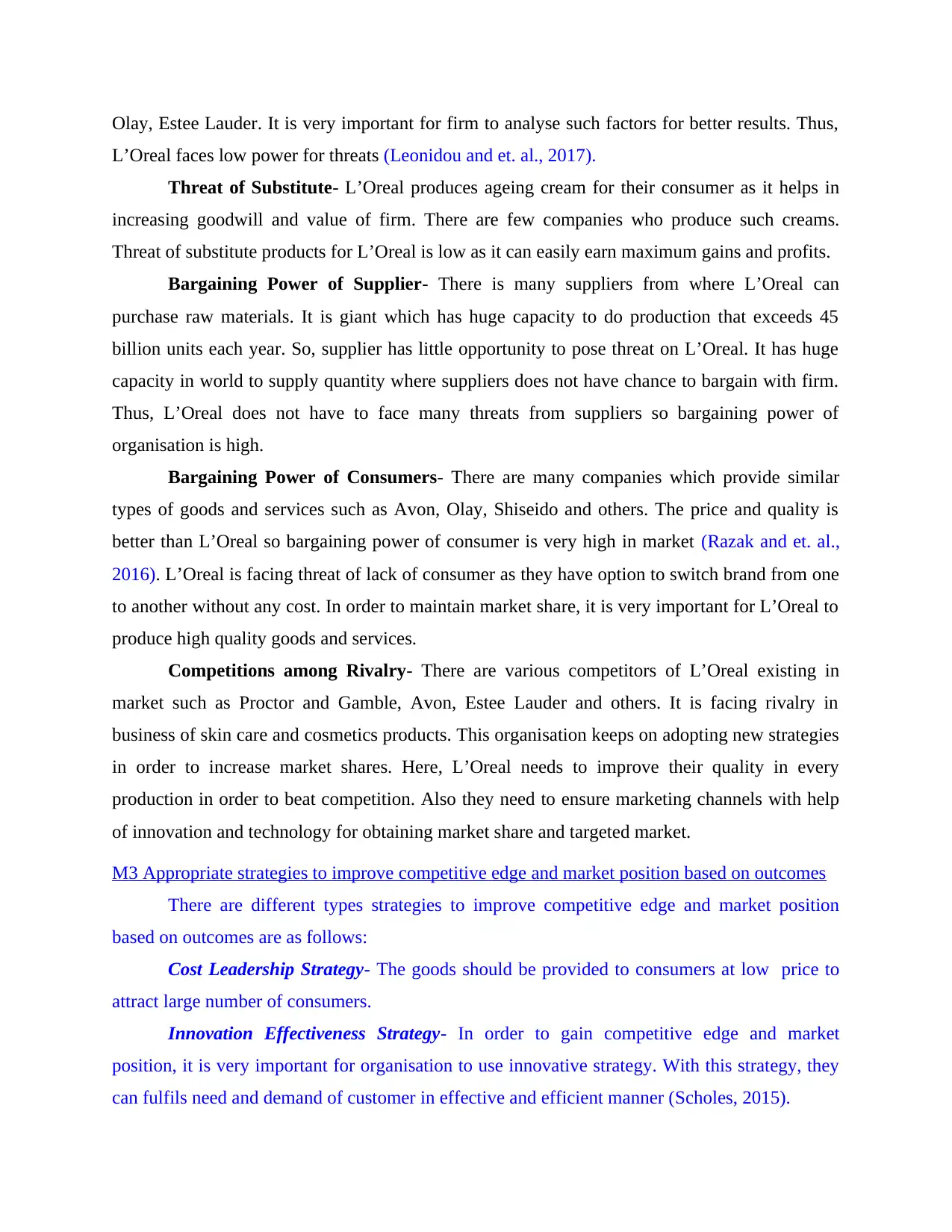
Olay, Estee Lauder. It is very important for firm to analyse such factors for better results. Thus,
L’Oreal faces low power for threats (Leonidou and et. al., 2017).
Threat of Substitute- L’Oreal produces ageing cream for their consumer as it helps in
increasing goodwill and value of firm. There are few companies who produce such creams.
Threat of substitute products for L’Oreal is low as it can easily earn maximum gains and profits.
Bargaining Power of Supplier- There is many suppliers from where L’Oreal can
purchase raw materials. It is giant which has huge capacity to do production that exceeds 45
billion units each year. So, supplier has little opportunity to pose threat on L’Oreal. It has huge
capacity in world to supply quantity where suppliers does not have chance to bargain with firm.
Thus, L’Oreal does not have to face many threats from suppliers so bargaining power of
organisation is high.
Bargaining Power of Consumers- There are many companies which provide similar
types of goods and services such as Avon, Olay, Shiseido and others. The price and quality is
better than L’Oreal so bargaining power of consumer is very high in market (Razak and et. al.,
2016). L’Oreal is facing threat of lack of consumer as they have option to switch brand from one
to another without any cost. In order to maintain market share, it is very important for L’Oreal to
produce high quality goods and services.
Competitions among Rivalry- There are various competitors of L’Oreal existing in
market such as Proctor and Gamble, Avon, Estee Lauder and others. It is facing rivalry in
business of skin care and cosmetics products. This organisation keeps on adopting new strategies
in order to increase market shares. Here, L’Oreal needs to improve their quality in every
production in order to beat competition. Also they need to ensure marketing channels with help
of innovation and technology for obtaining market share and targeted market.
M3 Appropriate strategies to improve competitive edge and market position based on outcomes
There are different types strategies to improve competitive edge and market position
based on outcomes are as follows:
Cost Leadership Strategy- The goods should be provided to consumers at low price to
attract large number of consumers.
Innovation Effectiveness Strategy- In order to gain competitive edge and market
position, it is very important for organisation to use innovative strategy. With this strategy, they
can fulfils need and demand of customer in effective and efficient manner (Scholes, 2015).
L’Oreal faces low power for threats (Leonidou and et. al., 2017).
Threat of Substitute- L’Oreal produces ageing cream for their consumer as it helps in
increasing goodwill and value of firm. There are few companies who produce such creams.
Threat of substitute products for L’Oreal is low as it can easily earn maximum gains and profits.
Bargaining Power of Supplier- There is many suppliers from where L’Oreal can
purchase raw materials. It is giant which has huge capacity to do production that exceeds 45
billion units each year. So, supplier has little opportunity to pose threat on L’Oreal. It has huge
capacity in world to supply quantity where suppliers does not have chance to bargain with firm.
Thus, L’Oreal does not have to face many threats from suppliers so bargaining power of
organisation is high.
Bargaining Power of Consumers- There are many companies which provide similar
types of goods and services such as Avon, Olay, Shiseido and others. The price and quality is
better than L’Oreal so bargaining power of consumer is very high in market (Razak and et. al.,
2016). L’Oreal is facing threat of lack of consumer as they have option to switch brand from one
to another without any cost. In order to maintain market share, it is very important for L’Oreal to
produce high quality goods and services.
Competitions among Rivalry- There are various competitors of L’Oreal existing in
market such as Proctor and Gamble, Avon, Estee Lauder and others. It is facing rivalry in
business of skin care and cosmetics products. This organisation keeps on adopting new strategies
in order to increase market shares. Here, L’Oreal needs to improve their quality in every
production in order to beat competition. Also they need to ensure marketing channels with help
of innovation and technology for obtaining market share and targeted market.
M3 Appropriate strategies to improve competitive edge and market position based on outcomes
There are different types strategies to improve competitive edge and market position
based on outcomes are as follows:
Cost Leadership Strategy- The goods should be provided to consumers at low price to
attract large number of consumers.
Innovation Effectiveness Strategy- In order to gain competitive edge and market
position, it is very important for organisation to use innovative strategy. With this strategy, they
can fulfils need and demand of customer in effective and efficient manner (Scholes, 2015).
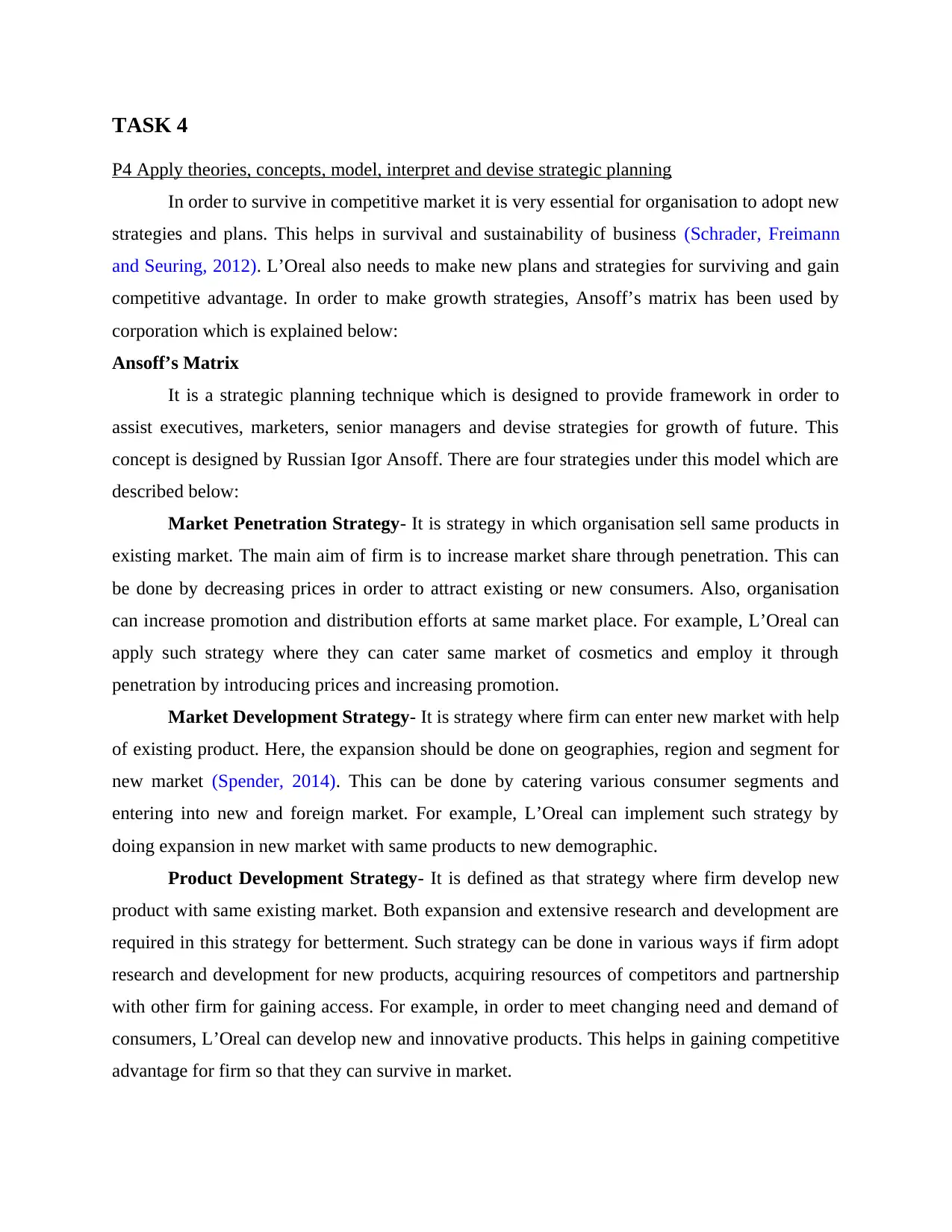
TASK 4
P4 Apply theories, concepts, model, interpret and devise strategic planning
In order to survive in competitive market it is very essential for organisation to adopt new
strategies and plans. This helps in survival and sustainability of business (Schrader, Freimann
and Seuring, 2012). L’Oreal also needs to make new plans and strategies for surviving and gain
competitive advantage. In order to make growth strategies, Ansoff’s matrix has been used by
corporation which is explained below:
Ansoff’s Matrix
It is a strategic planning technique which is designed to provide framework in order to
assist executives, marketers, senior managers and devise strategies for growth of future. This
concept is designed by Russian Igor Ansoff. There are four strategies under this model which are
described below:
Market Penetration Strategy- It is strategy in which organisation sell same products in
existing market. The main aim of firm is to increase market share through penetration. This can
be done by decreasing prices in order to attract existing or new consumers. Also, organisation
can increase promotion and distribution efforts at same market place. For example, L’Oreal can
apply such strategy where they can cater same market of cosmetics and employ it through
penetration by introducing prices and increasing promotion.
Market Development Strategy- It is strategy where firm can enter new market with help
of existing product. Here, the expansion should be done on geographies, region and segment for
new market (Spender, 2014). This can be done by catering various consumer segments and
entering into new and foreign market. For example, L’Oreal can implement such strategy by
doing expansion in new market with same products to new demographic.
Product Development Strategy- It is defined as that strategy where firm develop new
product with same existing market. Both expansion and extensive research and development are
required in this strategy for betterment. Such strategy can be done in various ways if firm adopt
research and development for new products, acquiring resources of competitors and partnership
with other firm for gaining access. For example, in order to meet changing need and demand of
consumers, L’Oreal can develop new and innovative products. This helps in gaining competitive
advantage for firm so that they can survive in market.
P4 Apply theories, concepts, model, interpret and devise strategic planning
In order to survive in competitive market it is very essential for organisation to adopt new
strategies and plans. This helps in survival and sustainability of business (Schrader, Freimann
and Seuring, 2012). L’Oreal also needs to make new plans and strategies for surviving and gain
competitive advantage. In order to make growth strategies, Ansoff’s matrix has been used by
corporation which is explained below:
Ansoff’s Matrix
It is a strategic planning technique which is designed to provide framework in order to
assist executives, marketers, senior managers and devise strategies for growth of future. This
concept is designed by Russian Igor Ansoff. There are four strategies under this model which are
described below:
Market Penetration Strategy- It is strategy in which organisation sell same products in
existing market. The main aim of firm is to increase market share through penetration. This can
be done by decreasing prices in order to attract existing or new consumers. Also, organisation
can increase promotion and distribution efforts at same market place. For example, L’Oreal can
apply such strategy where they can cater same market of cosmetics and employ it through
penetration by introducing prices and increasing promotion.
Market Development Strategy- It is strategy where firm can enter new market with help
of existing product. Here, the expansion should be done on geographies, region and segment for
new market (Spender, 2014). This can be done by catering various consumer segments and
entering into new and foreign market. For example, L’Oreal can implement such strategy by
doing expansion in new market with same products to new demographic.
Product Development Strategy- It is defined as that strategy where firm develop new
product with same existing market. Both expansion and extensive research and development are
required in this strategy for betterment. Such strategy can be done in various ways if firm adopt
research and development for new products, acquiring resources of competitors and partnership
with other firm for gaining access. For example, in order to meet changing need and demand of
consumers, L’Oreal can develop new and innovative products. This helps in gaining competitive
advantage for firm so that they can survive in market.
⊘ This is a preview!⊘
Do you want full access?
Subscribe today to unlock all pages.

Trusted by 1+ million students worldwide
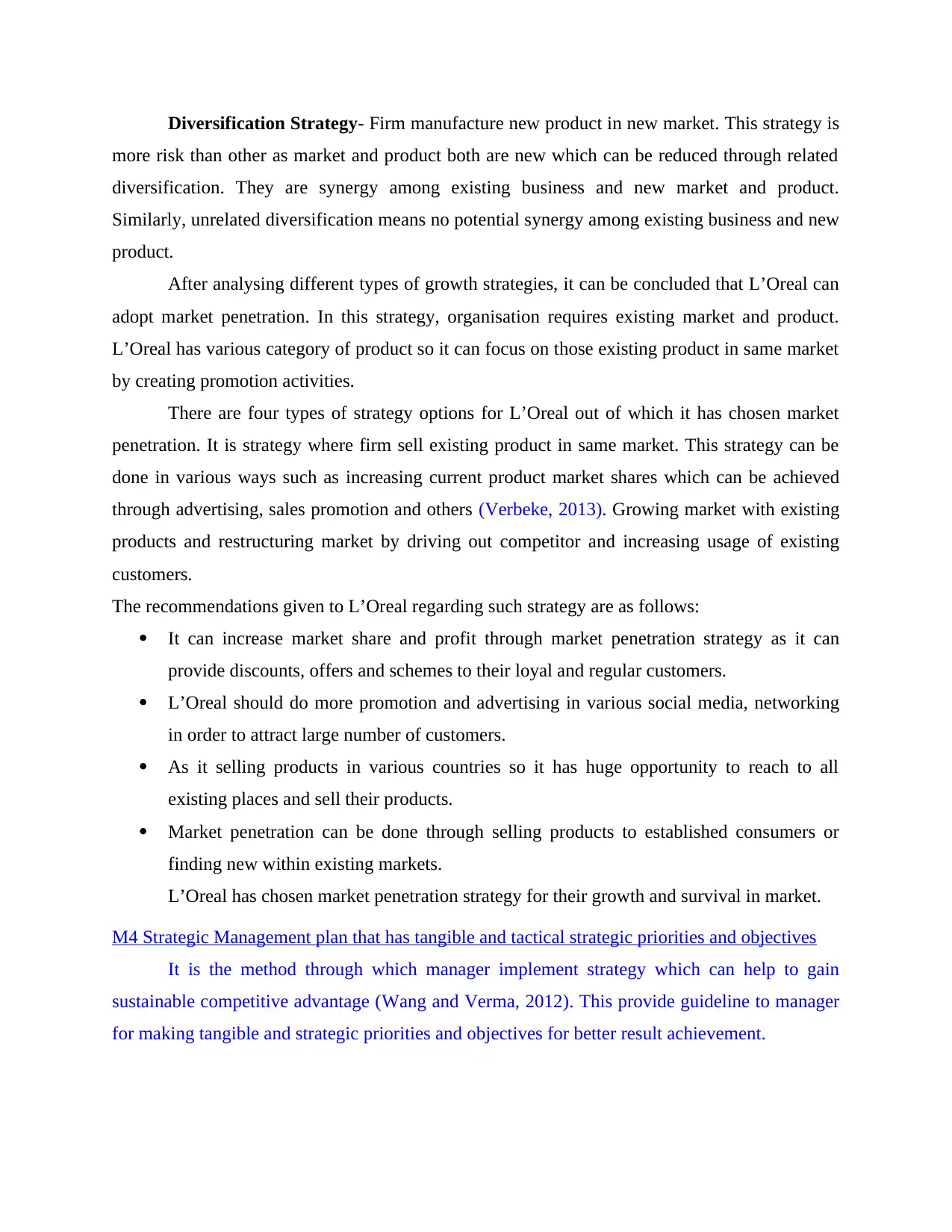
Diversification Strategy- Firm manufacture new product in new market. This strategy is
more risk than other as market and product both are new which can be reduced through related
diversification. They are synergy among existing business and new market and product.
Similarly, unrelated diversification means no potential synergy among existing business and new
product.
After analysing different types of growth strategies, it can be concluded that L’Oreal can
adopt market penetration. In this strategy, organisation requires existing market and product.
L’Oreal has various category of product so it can focus on those existing product in same market
by creating promotion activities.
There are four types of strategy options for L’Oreal out of which it has chosen market
penetration. It is strategy where firm sell existing product in same market. This strategy can be
done in various ways such as increasing current product market shares which can be achieved
through advertising, sales promotion and others (Verbeke, 2013). Growing market with existing
products and restructuring market by driving out competitor and increasing usage of existing
customers.
The recommendations given to L’Oreal regarding such strategy are as follows:
It can increase market share and profit through market penetration strategy as it can
provide discounts, offers and schemes to their loyal and regular customers.
L’Oreal should do more promotion and advertising in various social media, networking
in order to attract large number of customers.
As it selling products in various countries so it has huge opportunity to reach to all
existing places and sell their products.
Market penetration can be done through selling products to established consumers or
finding new within existing markets.
L’Oreal has chosen market penetration strategy for their growth and survival in market.
M4 Strategic Management plan that has tangible and tactical strategic priorities and objectives
It is the method through which manager implement strategy which can help to gain
sustainable competitive advantage (Wang and Verma, 2012). This provide guideline to manager
for making tangible and strategic priorities and objectives for better result achievement.
more risk than other as market and product both are new which can be reduced through related
diversification. They are synergy among existing business and new market and product.
Similarly, unrelated diversification means no potential synergy among existing business and new
product.
After analysing different types of growth strategies, it can be concluded that L’Oreal can
adopt market penetration. In this strategy, organisation requires existing market and product.
L’Oreal has various category of product so it can focus on those existing product in same market
by creating promotion activities.
There are four types of strategy options for L’Oreal out of which it has chosen market
penetration. It is strategy where firm sell existing product in same market. This strategy can be
done in various ways such as increasing current product market shares which can be achieved
through advertising, sales promotion and others (Verbeke, 2013). Growing market with existing
products and restructuring market by driving out competitor and increasing usage of existing
customers.
The recommendations given to L’Oreal regarding such strategy are as follows:
It can increase market share and profit through market penetration strategy as it can
provide discounts, offers and schemes to their loyal and regular customers.
L’Oreal should do more promotion and advertising in various social media, networking
in order to attract large number of customers.
As it selling products in various countries so it has huge opportunity to reach to all
existing places and sell their products.
Market penetration can be done through selling products to established consumers or
finding new within existing markets.
L’Oreal has chosen market penetration strategy for their growth and survival in market.
M4 Strategic Management plan that has tangible and tactical strategic priorities and objectives
It is the method through which manager implement strategy which can help to gain
sustainable competitive advantage (Wang and Verma, 2012). This provide guideline to manager
for making tangible and strategic priorities and objectives for better result achievement.
Paraphrase This Document
Need a fresh take? Get an instant paraphrase of this document with our AI Paraphraser
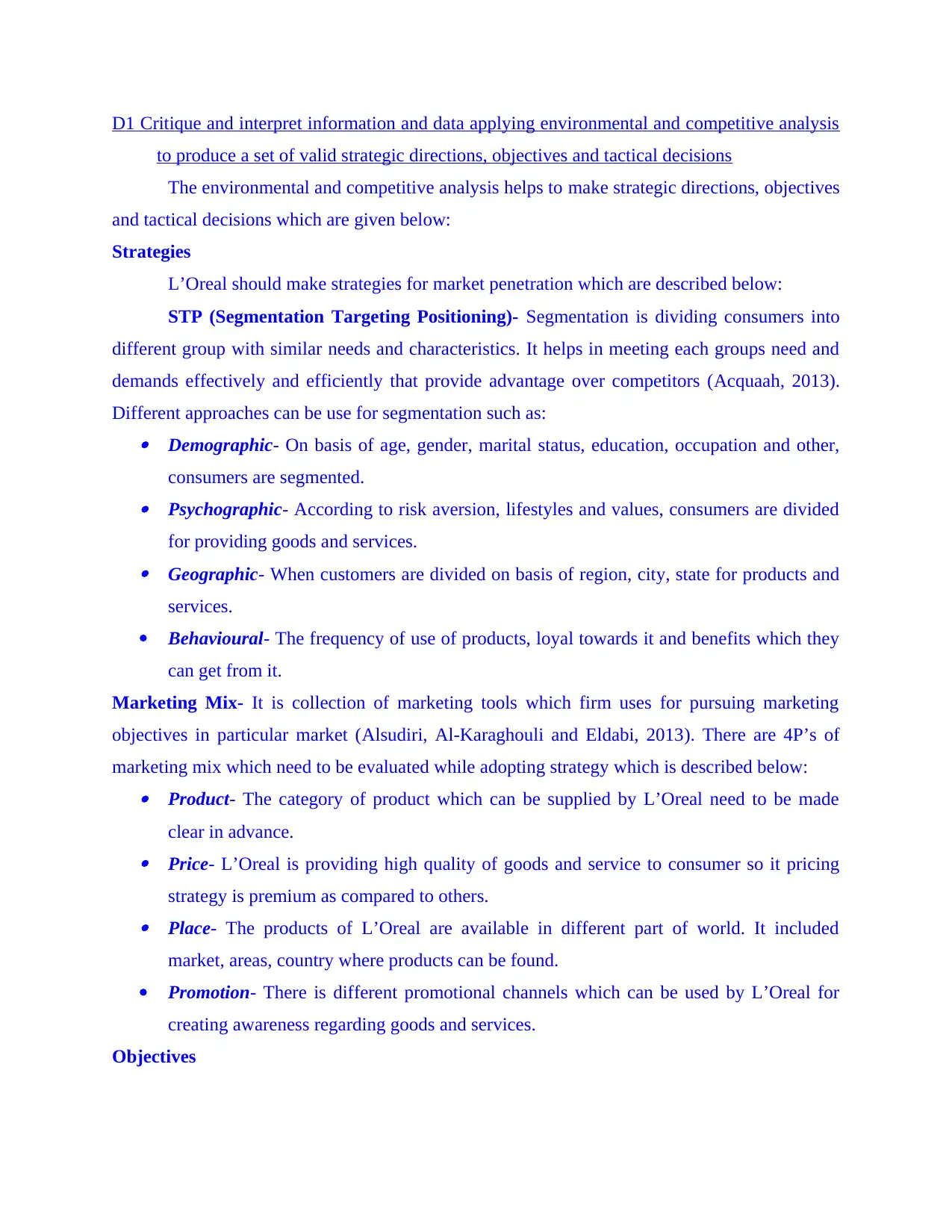
D1 Critique and interpret information and data applying environmental and competitive analysis
to produce a set of valid strategic directions, objectives and tactical decisions
The environmental and competitive analysis helps to make strategic directions, objectives
and tactical decisions which are given below:
Strategies
L’Oreal should make strategies for market penetration which are described below:
STP (Segmentation Targeting Positioning)- Segmentation is dividing consumers into
different group with similar needs and characteristics. It helps in meeting each groups need and
demands effectively and efficiently that provide advantage over competitors (Acquaah, 2013).
Different approaches can be use for segmentation such as: Demographic- On basis of age, gender, marital status, education, occupation and other,
consumers are segmented. Psychographic- According to risk aversion, lifestyles and values, consumers are divided
for providing goods and services. Geographic- When customers are divided on basis of region, city, state for products and
services.
Behavioural- The frequency of use of products, loyal towards it and benefits which they
can get from it.
Marketing Mix- It is collection of marketing tools which firm uses for pursuing marketing
objectives in particular market (Alsudiri, Al-Karaghouli and Eldabi, 2013). There are 4P’s of
marketing mix which need to be evaluated while adopting strategy which is described below: Product- The category of product which can be supplied by L’Oreal need to be made
clear in advance. Price- L’Oreal is providing high quality of goods and service to consumer so it pricing
strategy is premium as compared to others. Place- The products of L’Oreal are available in different part of world. It included
market, areas, country where products can be found.
Promotion- There is different promotional channels which can be used by L’Oreal for
creating awareness regarding goods and services.
Objectives
to produce a set of valid strategic directions, objectives and tactical decisions
The environmental and competitive analysis helps to make strategic directions, objectives
and tactical decisions which are given below:
Strategies
L’Oreal should make strategies for market penetration which are described below:
STP (Segmentation Targeting Positioning)- Segmentation is dividing consumers into
different group with similar needs and characteristics. It helps in meeting each groups need and
demands effectively and efficiently that provide advantage over competitors (Acquaah, 2013).
Different approaches can be use for segmentation such as: Demographic- On basis of age, gender, marital status, education, occupation and other,
consumers are segmented. Psychographic- According to risk aversion, lifestyles and values, consumers are divided
for providing goods and services. Geographic- When customers are divided on basis of region, city, state for products and
services.
Behavioural- The frequency of use of products, loyal towards it and benefits which they
can get from it.
Marketing Mix- It is collection of marketing tools which firm uses for pursuing marketing
objectives in particular market (Alsudiri, Al-Karaghouli and Eldabi, 2013). There are 4P’s of
marketing mix which need to be evaluated while adopting strategy which is described below: Product- The category of product which can be supplied by L’Oreal need to be made
clear in advance. Price- L’Oreal is providing high quality of goods and service to consumer so it pricing
strategy is premium as compared to others. Place- The products of L’Oreal are available in different part of world. It included
market, areas, country where products can be found.
Promotion- There is different promotional channels which can be used by L’Oreal for
creating awareness regarding goods and services.
Objectives
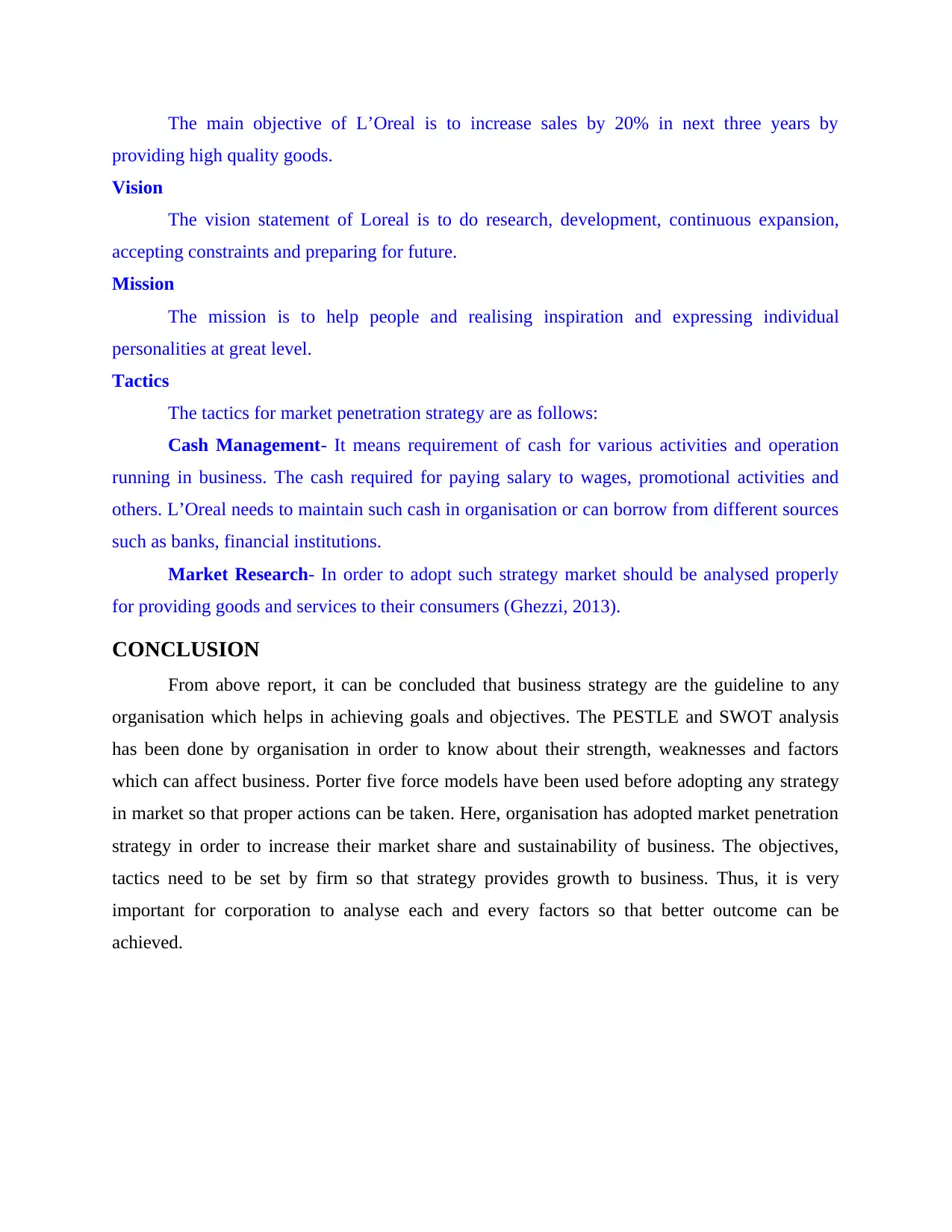
The main objective of L’Oreal is to increase sales by 20% in next three years by
providing high quality goods.
Vision
The vision statement of Loreal is to do research, development, continuous expansion,
accepting constraints and preparing for future.
Mission
The mission is to help people and realising inspiration and expressing individual
personalities at great level.
Tactics
The tactics for market penetration strategy are as follows:
Cash Management- It means requirement of cash for various activities and operation
running in business. The cash required for paying salary to wages, promotional activities and
others. L’Oreal needs to maintain such cash in organisation or can borrow from different sources
such as banks, financial institutions.
Market Research- In order to adopt such strategy market should be analysed properly
for providing goods and services to their consumers (Ghezzi, 2013).
CONCLUSION
From above report, it can be concluded that business strategy are the guideline to any
organisation which helps in achieving goals and objectives. The PESTLE and SWOT analysis
has been done by organisation in order to know about their strength, weaknesses and factors
which can affect business. Porter five force models have been used before adopting any strategy
in market so that proper actions can be taken. Here, organisation has adopted market penetration
strategy in order to increase their market share and sustainability of business. The objectives,
tactics need to be set by firm so that strategy provides growth to business. Thus, it is very
important for corporation to analyse each and every factors so that better outcome can be
achieved.
providing high quality goods.
Vision
The vision statement of Loreal is to do research, development, continuous expansion,
accepting constraints and preparing for future.
Mission
The mission is to help people and realising inspiration and expressing individual
personalities at great level.
Tactics
The tactics for market penetration strategy are as follows:
Cash Management- It means requirement of cash for various activities and operation
running in business. The cash required for paying salary to wages, promotional activities and
others. L’Oreal needs to maintain such cash in organisation or can borrow from different sources
such as banks, financial institutions.
Market Research- In order to adopt such strategy market should be analysed properly
for providing goods and services to their consumers (Ghezzi, 2013).
CONCLUSION
From above report, it can be concluded that business strategy are the guideline to any
organisation which helps in achieving goals and objectives. The PESTLE and SWOT analysis
has been done by organisation in order to know about their strength, weaknesses and factors
which can affect business. Porter five force models have been used before adopting any strategy
in market so that proper actions can be taken. Here, organisation has adopted market penetration
strategy in order to increase their market share and sustainability of business. The objectives,
tactics need to be set by firm so that strategy provides growth to business. Thus, it is very
important for corporation to analyse each and every factors so that better outcome can be
achieved.
⊘ This is a preview!⊘
Do you want full access?
Subscribe today to unlock all pages.

Trusted by 1+ million students worldwide
1 out of 16
Related Documents
Your All-in-One AI-Powered Toolkit for Academic Success.
+13062052269
info@desklib.com
Available 24*7 on WhatsApp / Email
![[object Object]](/_next/static/media/star-bottom.7253800d.svg)
Unlock your academic potential
Copyright © 2020–2025 A2Z Services. All Rights Reserved. Developed and managed by ZUCOL.




